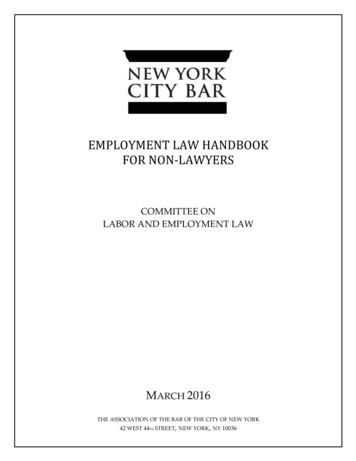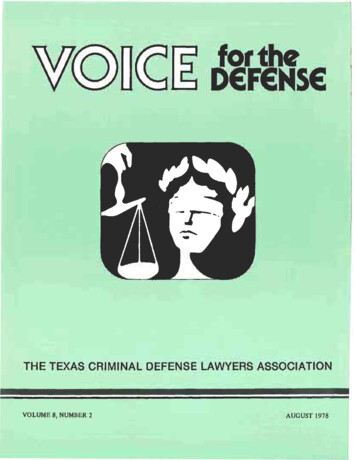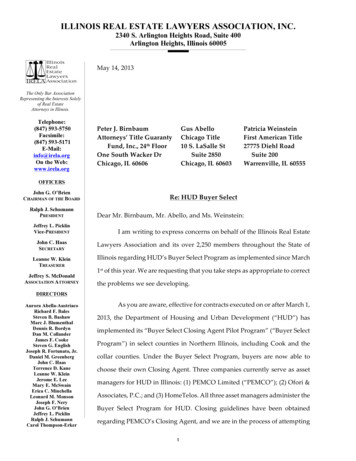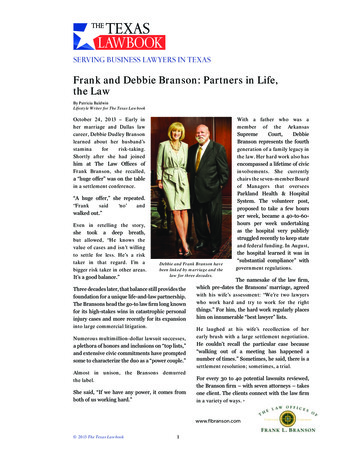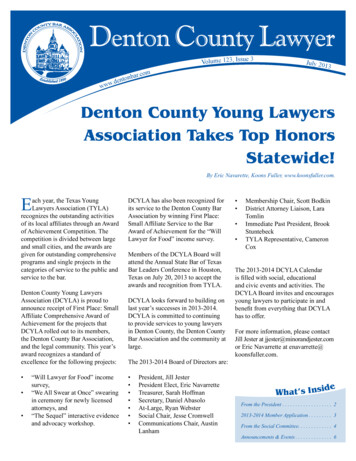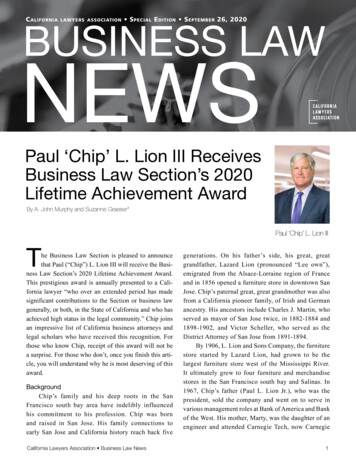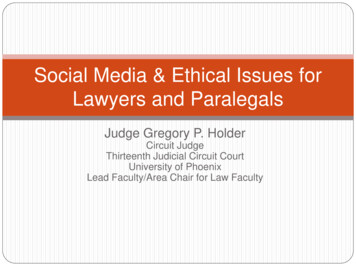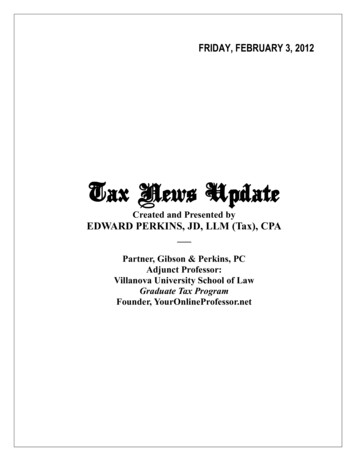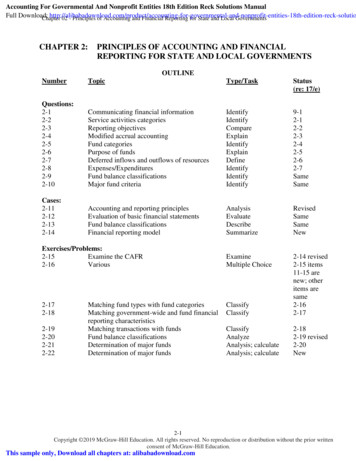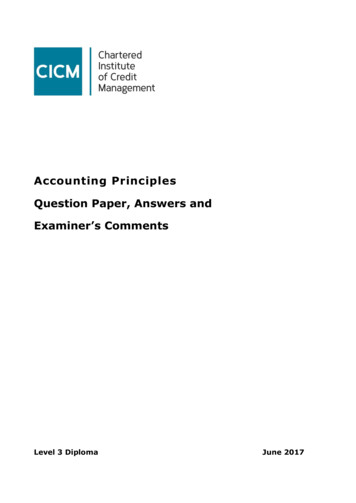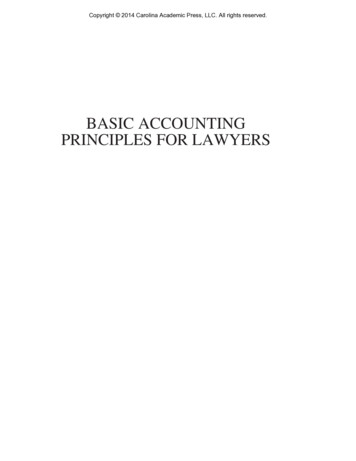
Transcription
Copyright 2014 Carolina Academic Press, LLC. All rights reserved.BASIC ACCOUNTINGPRINCIPLES FOR LAWYERS
Copyright 2014 Carolina Academic Press, LLC. All rights reserved.LexisNexis Law School PublishingAdvisory BoardPaul CaronProfessor of LawPepperdine University School of LawHerzog Summer Visiting Professor in TaxationUniversity of San Diego School of LawBridgette CarrClinical Professor of LawUniversity of Michigan Law SchoolOlympia DuhartProfessor of Law and Director of Lawyering Skills & Values ProgramNova Southeastern University, Shepard Broad Law SchoolSamuel EstreicherDwight D. Opperman Professor of LawDirector, Center for Labor and Employment LawNYU School of LawSteven I. FriedlandProfessor of Law and Senior ScholarElon University School of LawCarole GoldbergJonathan D. Varat Distinguished Professor of LawUCLA School of LawOliver GoodenoughProfessor of LawVermont Law SchoolPaul MarcusHaynes Professor of LawWilliam and Mary Law SchoolJohn SpranklingDistinguished Professor of LawMcGeorge School of Law
Copyright 2014 Carolina Academic Press, LLC. All rights reserved.BASIC ACCOUNTINGPRINCIPLES FORLAWYERSThird EditionC. Steven BradfordEarl Dunlap Distinguished Professor of LawUniversity of Nebraska College of Law
Copyright 2014 Carolina Academic Press, LLC. All rights reserved.Print ISBN: 978-1-6304-3078-8eBook ISBN: 978-1-6304-3079-5Library of Congress Cataloging-in-Publication DataBradford, C. Steven, 1956Basic accounting principles for lawyers / C. Steven Bradford, Earl Dunlap Distinguished Professor of Law, Universityof Nebraska College of Law. -- Third edition.p. cm.Includes bibliographical references and index.ISBN 978-1-6304-3078-81. Lawyers--United States--Accounting. 2. Lawyers--Accounting. I. Title.HF5686.L35B72 2014657.024'34--dc232014008781This publication is designed to provide authoritative information in regard to the subject matter covered. It is soldwith the understanding that the publisher is not engaged in rendering legal, accounting, or other professionalservices. If legal advice or other expert assistance is required, the services of a competent professional should besought.LexisNexis and the Knowledge Burst logo are registered trademarks of Reed Elsevier Properties Inc., used underlicense. Matthew Bender and the Matthew Bender Flame Design are registered trademarks of Matthew BenderProperties Inc.Copyright 2014 Matthew Bender & Company, Inc., a member of LexisNexis. All Rights Reserved.No copyright is claimed by LexisNexis or Matthew Bender & Company, Inc., in the text of statutes, regulations, andexcerpts from court opinions quoted within this work. Permission to copy material may be licensed for a fee fromthe Copyright Clearance Center, 222 Rosewood Drive, Danvers, Mass. 01923, telephone (978) 750-8400.NOTE TO USERSTo ensure that you are using the latest materials available in this area, please be sureto periodically check the LexisNexis Law School web site for downloadable updatesand supplements at www.lexisnexis.com/lawschool.Editorial Offices121 Chanlon Rd., New Providence, NJ 07974 (908) 464-6800201 Mission St., San Francisco, CA 94105-1831 (415) 908-3200www.lexisnexis.com(2014–Pub.3506)
Copyright 2014 Carolina Academic Press, LLC. All rights reserved.DedicationTo Raelyn, Payton, Quinten, Lofton, and Jordan, the five most wonderful grandchildrenanyone could possibly have. My time with all of you is pure joy.To my wife Sandy, for being willing to put up with someone like me on a daily basis and formaking each day of my life better than it would have been without her.Finally, to my mother for always being there when I needed her as a child, and for givingme a model of what humanity ought to be.iii
Copyright 2014 Carolina Academic Press, LLC. All rights reserved.
Copyright 2014 Carolina Academic Press, LLC. All rights reserved.Preface to the Third Edition“Money is always on the brain so long as there is a brain in reasonable order.”—Samuel ButlerEach edition of this book seems to precipitate a major crisis involving accounting. Thefirst edition was published in 1997; less than four years later Enron filed for bankruptcy,taking down the Arthur Andersen accounting firm with it. The second edition was publishedin 2008, shortly before the 2008 financial crisis. I hope the third edition doesn’t continue thisescalating trend but, just in case, you should probably stockpile food and invest in gold.You should also learn something about accounting. If nothing else, these eventsdemonstrate how important it is for lawyers to have a basic understanding of accountingprinciples.Significant changes have occurred since the second edition. Justin Bieber has replacedParis Hilton as the least talented celebrity. The Financial Accounting Standards Board(FASB) has codified generally accepted accounting principles. Congress passed the DoddFrank Act to “solve” the 2008 crisis, just as the Sarbanes-Oxley Act “solved” the previousproblems. (With Congress at the helm, I’m sure everything will work perfectly from nowon.)Some expected changes have not occurred. When I finished the second edition, I assumedthe third edition would discuss the SEC’s adoption of international accounting standards, orat least present a timetable for that adoption. But the move toward international standardshas slowed, at least in the United States. Nevertheless, the current audit and fraud issuesinvolving Chinese companies show that, not only are international issues unlikely todisappear, their importance is magnified in our increasingly interconnected world.This edition of the book builds on the two earlier editions, so everyone I thanked in theprefaces to the first two editions deserves continued thanks, especially Gary Adna Ames,who helped build the foundation on which this edition rests. I also want to thank BradPesicka, Kevin McVoy, Lucy Li, Sarah Safarik, and the NSA for reading and commentingon this edition. (The NSA didn’t provide any comments, but I’m sure they read it.) Kevin,I’m sorry I didn’t find the old files sooner; it would have made your work much easier.Finally, my gratitude (and love) to Sandy Placzek for being there when I need her, even ifthe need is for her to read a draft of a boring accounting book.Any errors in this book are, of course, the fault of Congress.C. Steven Bradfordv
Copyright 2014 Carolina Academic Press, LLC. All rights reserved.
Copyright 2014 Carolina Academic Press, LLC. All rights reserved.Preface to the Second Edition“I was never a certified public accountant. I just had a degree in accounting. It wouldrequire passing a test, which I would not have been able to do.”—Bob NewhartMuch has happened since the first edition of this little book was written. Paris Hiltonbecame famous.1 Enron collapsed, taking the Arthur Andersen accounting firm with it.Congress passed the Sarbanes-Oxley Act to “solve” the problem.2In addition to the people I thanked in the first edition of the book, my thanks to mymother, for showing reprints of everything I have ever written to the only other lawyer sheknows,3 to Justin Barager for his research assistance, and to Sandy Placzek, who has keptme sane4 while I tried to update this book, serve as President of the University of NebraskaLincoln Faculty Senate,5 and find the perfect Mexican restaurant.6Finally (and sadly), my co-author on the first edition of this book, Gary Adna Ames, is nolonger with us. He’s still alive, if you can call living in Rexburg, Idaho “alive.” But he’s nolonger a co-author of the book — something to do with the libel suits arising from the firstedition. I owe a great debt to Gary for his work on the first edition; his contributions remainevident throughout the book (including especially any libelous material).C. Steven Bradford1Or infamous. (Not that she would know the difference.)2That’s the Enron problem, not the Paris Hilton problem. So far, Congress has done nothing to solvethe Paris Hilton problem. Apparently, even Congress isn’t willing to tackle some problems.3I won’t tell you where Mom lives; she wants to keep her neighborhood relatively lawyer-free.4It’s a relative term.5That ought to tell you something about the collective judgment of the University of Nebraskafaculty.6Two out of three isn’t bad.vii
Copyright 2014 Carolina Academic Press, LLC. All rights reserved.
Copyright 2014 Carolina Academic Press, LLC. All rights reserved.Preface to the First EditionIt isn’t easy to write about accounting. Most people prefer disease, pestilence, and evenlaw school to reading about accounting. Many accounting books go out of their way toencourage this attitude; they are boring, pedantic,7 and humorless. The main lesson theyteach about accounting is that it’s something to be avoided at all cost.We’ve tried to make this book interesting and understandable for law students who haveno desire to become accountants. One of us (Professor Bradford) has little formal training inaccounting. He remembers what it was like to encounter this subject for the first time. Theother (Professor Ames) teaches introductory accounting to undergraduates. He’s constantlyreminded of what it’s like for students to encounter this subject for the first time.We’ve tried to transform accounting concepts into clear, conversational English and toinject some humor into the subject. Accounting is dry enough; we see no reason to make itdrier. And we’ve limited the scope of the book to the basic details that every lawyer and lawstudent should know. This is not a treatise on accounting but a relatively short introductionto the essentials.Our book is designed to be used for a short mini-course on accounting, or as a supplementin courses that touch on accounting issues. It is not intended to be used as the primary textfor the typical two or three-credit law and accounting course, although it could be used as asupplement in such a course.Professor Bradford thanks his colleagues at the University of Nebraska College of Lawfor their contributions to this book. In their defense, they try to stop his silliness, butconsistently fail. Professor Bradford also thanks his wife Meg and his four wonderfulchildren — Jason, Allison, John, and Anne. They realize Daddy is a little goofy, but they putup with him anyway. They in turn inspire Daddy to accomplish what little he accomplishes.Meg deserves a special thanks for her valuable comments on the manuscript.Professor Ames thanks Professor Bradford, who first had the idea to write this book (andwho, therefore, deserves most of the blame). He also thanks his wife Lynn and his seven(that’s right, SEVEN) children: Daniel, Jessica, Tyler, Jacob, Stephen, Carly, and Rachel.Without them, his life would be as dull and drab as every other accountant’s. Because ofthem, he has great happiness and a longer dedication than he otherwise would have had.Both of us are grateful to Meg Bradford, Thomas R. Craig, Bill Lyons, and SteveWillborn for reading the manuscript of this book. Their comments have made the bookbetter. We thank the people at Anderson Publishing for helping to make this book a reality.When we first contacted them, the book was nothing more than a vague idea in our minds;Anderson helped to turn that idea into a reality. Given the state of our minds, that’s quite anaccomplishment. We also appreciate their patience in waiting for us to finish.7We promise this is the last word we’ll use that we had to look up to verify its meaning.ix
Copyright 2014 Carolina Academic Press, LLC. All rights reserved.Preface to the First EditionFinally, this has been a cooperative effort. Each author would like to stress that any faultsin this book are solely the responsibility of the other.Steve BradfordGary Adna Amesx
Copyright 2014 Carolina Academic Press, LLC. All rights reserved.Using This Book“If the subject matter isn’t inherently interesting — accounting comes to mind — I’ve got tomake it amusing, if only to keep myself awake.”—Allan SloanKey Concepts to RememberA text box at the end of each chapter contains key concepts to remember. This box is notintended as a substitute for reading the chapter, but to help you recall key points.GlossaryA glossary appears at the end of the book. It defines many of the terms used in the book.FootnotesThis book contains many footnotes, but don’t feel obligated to read them. The footnotesin this book aren’t like the footnotes in casebooks and law reviews. You can skip myfootnotes and not miss anything important.8 The footnotes in this book are of three types:(1) humorous comments; (2) citations; and (3) anal-retentive stuff.1. Humorous Comments. These are the most important footnotes. In this book, I make funof accounting, accountants, law students, professors, and everyone else I could think of tooffend.9 Where my attempts at humor would have broken up the text, I have relegated themto the footnotes. Read these footnotes to remain sane as you learn accounting.2. Citations. Unlike the authors of law review articles, I haven’t provided a citation foreverything I say including the meaning of the word “the.” I usually only provide a citationwhen I’m directly quoting or otherwise owe a special debt to a particular source. You canignore the citation footnotes unless you’re a law review editor and want to check their form,which is usually wrong.3. Anal-Retentive Stuff. Occasionally, the footnotes contain qualifications or explanatorymaterial that I thought some anal-retentive people might demand. These footnotes aren’tessential to understanding the basic principles in the text, but they make the book appearmore intellectual so your law professor will require you to buy it. I sometimes begin thesefootnotes by telling you not to read them. If you’re as anal-retentive as I am,10 feel free toread them. If not, ignore them.8On second thought, perhaps the footnotes in this book are like the footnotes in casebooks and lawreviews.9If I left anyone out, please let me know, and I will try to offend them in a future edition.10I doubt it. I was voted the Anal-Retentive Law Professor of the Year, which is akin to being thefilthiest pig in the sty.xi
Copyright 2014 Carolina Academic Press, LLC. All rights reserved.
Copyright 2014 Carolina Academic Press, LLC. All rights reserved.Table of ContentsSECTION ONEINTRODUCTION TO ACCOUNTING . . . . . . . . . . . . . . . . 1Chapter 1INTRODUCTION . . . . . . . . . . . . . . . . . . . . . . . . . . . . . . . . . . 3Chapter 2THE BALANCE SHEET: ASSETS, LIABILITIES, ANDEQUITY . . . . . . . . . . . . . . . . . . . . . . . . . . . . . . . . . . . . . . . . . 7Chapter 3THE INCOME STATEMENT: REVENUES, EXPENSES, ANDNET INCOME OR LOSS . . . . . . . . . . . . . . . . . . . . . . . . . . . 11Chapter 4CONSOLIDATED FINANCIAL STATEMENTS . . . . . . . . . . 15SECTION TWOMORE ABOUT THE BALANCE SHEET . . . . . . . . . . . . . 17Chapter 5DOUBLE-ENTRY BOOKKEEPING: HOW TRANSACTIONSAFFECT THE BALANCE SHEET . . . . . . . . . . . . . . . . . . . . 19Chapter 6THE EQUITY SECTION OF THE BALANCE SHEET . . . . . 29Chapter 7INSOLVENCY . . . . . . . . . . . . . . . . . . . . . . . . . . . . . . . . . . . 37SECTION THREEACCRUAL, DEFERRAL, AND CASH FLOW . . . . . . . 41Chapter 8ACCRUAL AND DEFERRAL . . . . . . . . . . . . . . . . . . . . . . . . 43Chapter 9DEPRECIATION, DEPLETION, AND AMORTIZATION . . 49Chapter 10INVENTORY . . . . . . . . . . . . . . . . . . . . . . . . . . . . . . . . . . . . 55Chapter 11CONTINGENCIES . . . . . . . . . . . . . . . . . . . . . . . . . . . . . . . . 61Chapter 12CASH FLOW: THE STATEMENT OF CASH FLOWS . . . . . 65xiii
Copyright 2014 Carolina Academic Press, LLC. All rights reserved.Table of ContentsSECTION FOURChapter 13THE ACCOUNTING ENVIRONMENT . . . . . . . . . . . . . 71INTRODUCTION TO THE ACCOUNTINGENVIRONMENT . . . . . . . . . . . . . . . . . . . . . . . . . . . . . . . . .73Chapter 14GENERALLY ACCEPTED ACCOUNTING PRINCIPLES . . 75Chapter 15NOTES TO THE FINANCIAL STATEMENTS; MD&A . . . . 79Chapter 16AUDITING . . . . . . . . . . . . . . . . . . . . . . . . . . . . . . . . . . . . . . 83Chapter 17LAWYERS’ RESPONSES TO AUDIT INQUIRIES . . . . . . . . 87Chapter 18INTERNAL ACCOUNTING CONTROLS . . . . . . . . . . . . . .Chapter 19GOVERNMENTAL ACCOUNTING . . . . . . . . . . . . . . . . . . . 95SECTION FIVEChapter 20SECTION SIX91THE UNCERTAINTY OF ACCOUNTING . . . . . . . . . . . . 97THE UNCERTAINTY OF ACCOUNTING . . . . . . . . . . . . . . 99OTHER VALUATION CONCEPTS . . . . . . . . . . . . . . . . . 107Chapter 21COST ACCOUNTING . . . . . . . . . . . . . . . . . . . . . . . . . . . . . 109Chapter 22PRESENT VALUE AND THE TIME VALUE OF MONEY . 115Chapter 23EXPECTED VALUE . . . . . . . . . . . . . . . . . . . . . . . . . . . . . . 125GLOSSARY . . . . . . . . . . . . . . . . . . . . . . . . . . . . . . . . . . . . . . . . . . . . . . . . . . . . 133INDEX . . . . . . . . . . . . . . . . . . . . . . . . . . . . . . . . . . . . . . . . . . . . . . . . . . . . . . . . . I-1xiv
Accounting is dry enough; we see no reason to make it drier. And we’ve limited the scope of the book to the basic details that every lawyer and law student should know. This is not a treatise on accounting but a relatively short introduction to the essentials. Our book is designed to be used for a shor

